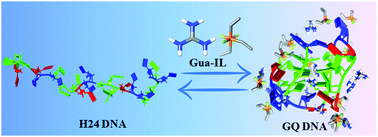Ionic liquid induced G-quadruplex formation and stabilization: spectroscopic and simulation studies†
Abstract
Among different polymorphs of DNA, G-quadruplex (GQ) formation in guanine rich sequences has received special attention due to its direct relevance to cellular aging and abnormal cell growths. To date, smaller ions like Na+, K+, Li+, and NH4+ are the best possible selective GQ stabilizing materials. Herein, we report that an ionic liquid (IL), i.e. guanidinium tris(pentafluoroethyl)trifluorophosphate, can not only instigate the GQ formation in the absence of conventional GQ forming ions (like Na+, K+, NH4+, etc.), but also stabilizes the GQ structure. This conformational transition has been confirmed through different spectroscopic tools and molecular dynamics (MD) simulation studies. MD simulation shows that one of the guanidinium cations resides in the G-tetrad core, while bulky anions prefer to stay near the GQ surface resulting in GQ formation and stabilization. This study thus brings out a special type of ionic liquid that acts as a GQ stabilizer. The origin of GQ stabilization by IL presented here may also help in the future design of IL for GQ formation and stabilization.



 Please wait while we load your content...
Please wait while we load your content...